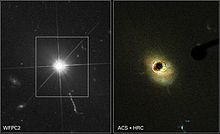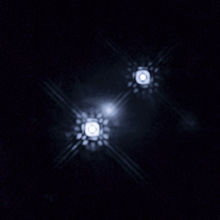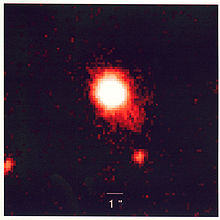- Quasar
-
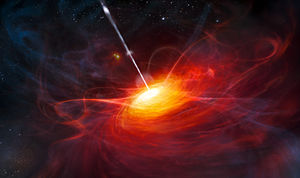 Artist's rendering of ULAS J1120+0641, a very distant quasar powered by a black hole with a mass two billion times that of the Sun[1]. Credit: ESO/M. Kornmesser
Artist's rendering of ULAS J1120+0641, a very distant quasar powered by a black hole with a mass two billion times that of the Sun[1]. Credit: ESO/M. Kornmesser
A quasi-stellar radio source ("quasar") is a very energetic and distant active galactic nucleus. Quasars are extremely luminous and were first identified as being high redshift sources of electromagnetic energy, including radio waves and visible light, that were point-like, similar to stars, rather than extended sources similar to galaxies.
While the nature of these objects was controversial until as recently as the early 1980s, there is now a scientific consensus that a quasar is a compact region in the center of a massive galaxy surrounding its central supermassive black hole. Its size is 10–10,000 times the Schwarzschild radius of the black hole. The quasar is powered by an accretion disc around the black hole.
Contents
Overview
Quasars show a very high redshift, which is an effect of the expansion of the universe between the quasar and the Earth.[2] They are among the most luminous, powerful, and energetic objects known in the universe. They tend to inhabit the very centers of active young galaxies and can emit up to a thousand times the energy output of the Milky Way. When combined with Hubble's law, the implication of the redshift is that the quasars are very distant—and thus, it follows, objects from much earlier in the universe's history. The most luminous quasars radiate at a rate that can exceed the output of average galaxies, equivalent to one trillion (1012) suns. This radiation is emitted across the spectrum, almost equally, from X-rays to the far-infrared with a peak in the ultraviolet-optical bands, with some quasars also being strong sources of radio emission and of gamma-rays. In early optical images, quasars looked like single points of light (i.e., point sources), indistinguishable from stars, except for their peculiar spectra. With infrared telescopes and the Hubble Space Telescope, the "host galaxies" surrounding the quasars have been identified in some cases.[3] These galaxies are normally too dim to be seen against the glare of the quasar, except with these special techniques. Most quasars cannot be seen with small telescopes, but 3C 273, with an average apparent magnitude of 12.9, is an exception. At a distance of 2.44 billion light-years, it is one of the most distant objects directly observable with amateur equipment.
Some quasars display changes in luminosity which are rapid in the optical range and even more rapid in the X-rays. Because these changes occur very rapidly they define an upper limit on the volume of a quasar; quasars are not much larger than the Solar System.[4] This implies an astonishingly high energy density.[5] The mechanism of brightness changes probably involves relativistic beaming of jets pointed nearly directly toward us. The highest redshift quasar known (as of June 2011[update]) is ULAS_J1120+0641, with a redshift of 7.085, which corresponds to a proper distance of approximately 29 billion light-years from Earth.
Quasars are believed to be powered by accretion of material into supermassive black holes in the nuclei of distant galaxies, making these luminous versions of the general class of objects known as active galaxies. Since light cannot escape the super massive black holes that are at the centre of quasars, the escaping energy is actually generated outside the event horizon by gravitational stresses and immense friction on the incoming material.[6] Large central masses (106 to 109 Solar masses) have been measured in quasars using 'reverberation mapping'. Several dozen nearby large galaxies, with no sign of a quasar nucleus, have been shown to contain a similar central black hole in their nuclei, so it is thought that all large galaxies have one, but only a small fraction emit powerful radiation and so are seen as quasars. The matter accreting onto the black hole is unlikely to fall directly in, but will have some angular momentum around the black hole that will cause the matter to collect in an accretion disc. Quasars may also be ignited or re-ignited from normal galaxies when infused with a fresh source of matter. In fact, it has been theorized that a quasar could form as the Andromeda Galaxy collides with our own Milky Way galaxy in approximately 3–5 billion years.[6][7][8]
Properties
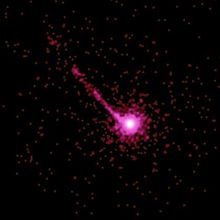 The Chandra X-ray image is of the quasar PKS 1127-145, a highly luminous source of X-rays and visible light about 10 billion light years from Earth. An enormous X-ray jet extends at least a million light years from the quasar. Image is 60 arcsec on a side. RA 11h 30m 7.10s Dec -14° 49' 27" in Crater. Observation date: May 28, 2000. Instrument: ACIS.
The Chandra X-ray image is of the quasar PKS 1127-145, a highly luminous source of X-rays and visible light about 10 billion light years from Earth. An enormous X-ray jet extends at least a million light years from the quasar. Image is 60 arcsec on a side. RA 11h 30m 7.10s Dec -14° 49' 27" in Crater. Observation date: May 28, 2000. Instrument: ACIS.
More than 200,000 quasars are known, most from the Sloan Digital Sky Survey. All observed quasar spectra have redshifts between 0.056 and 7.085. Applying Hubble's law to these redshifts, it can be shown that they are between 600 million[9] and 28 billion light-years away (in terms of proper distance). Because of the great distances to the furthest quasars and the finite velocity of light, we see them and their surrounding space as they existed in the very early universe.
Most quasars are known to be farther than three billion light-years away. Although quasars appear faint when viewed from Earth, the fact that they are visible at all from so far away, is due to quasars being the most luminous objects in the known universe. The quasar that appears brightest in the sky is 3C 273 in the constellation of Virgo. It has an average apparent magnitude of 12.8 (bright enough to be seen through a medium-size amateur telescope), but it has an absolute magnitude of −26.7. From a distance of about 33 light-years, this object would shine in the sky about as brightly as our sun. This quasar's luminosity is, therefore, about 2 trillion (2 × 1012) times that of our sun, or about 100 times that of the total light of average giant galaxies like our Milky Way. However, this assumes the quasar is radiating energy in all directions. An active galactic nucleus can be associated with a powerful jet of matter and energy; it need not be radiating in all directions. In a universe containing hundreds of billions of galaxies, most of which had active nuclei billions of years ago and would be seen located billions of light-years away, it is statistically certain that thousands of energy jets are pointed toward us, some more directly than others. In many cases it is likely that the brighter the quasar, the more directly its jet is aimed at us.
The hyperluminous quasar APM 08279+5255 was, when discovered in 1998, given an absolute magnitude of −32.2, although high resolution imaging with the Hubble Space Telescope and the 10 m Keck Telescope revealed that this system is gravitationally lensed. A study of the gravitational lensing in this system suggests that it has been magnified by a factor of ~10. It is still substantially more luminous than nearby quasars such as 3C 273.
Quasars were much more common in the early universe. This discovery by Maarten Schmidt in 1967 was early strong evidence against the Steady State cosmology of Fred Hoyle, and in favor of the Big Bang cosmology. Quasars show where massive black holes are growing rapidly (via accretion). These black holes grow in step with the mass of stars in their host galaxy in a way not understood at present. One idea is that the jets, radiation and winds from quasars shut down the formation of new stars in the host galaxy, a process called 'feedback'. The jets that produce strong radio emission in some quasars at the centers of clusters of galaxies are known to have enough power to prevent the hot gas in these clusters from cooling and falling down onto the central galaxy.
Quasars are found to vary in luminosity on a variety of time scales. Some vary in brightness every few months, weeks, days, or hours. This means that quasars generate and emit their energy from a very small region, since each part of the quasar would have to be in contact with other parts on such a time scale to coordinate the luminosity variations. As such, a quasar varying on the time scale of a few weeks cannot be larger than a few light-weeks across. The emission of large amounts of power from a small region requires a power source far more efficient than the nuclear fusion which powers stars. The release of gravitational energy[citation needed] by matter falling towards a massive black hole is the only process known that can produce such high power continuously. (Stellar explosions—supernovas and gamma-ray bursts—can do so, but only for a few weeks.) Black holes were considered too exotic by some astronomers in the 1960s, and they suggested that the redshifts arose from some other (unknown) process, so that the quasars were not really so distant as the Hubble law implied. This 'redshift controversy' lasted for many years. Many lines of evidence (seeing host galaxies, finding 'intervening' absorption lines, gravitational lensing) now demonstrate that the quasar redshifts are due to the Hubble expansion, and quasars are as powerful as first thought.[10]
Quasars have all the same properties as active galaxies, but are more powerful: their radiation is partially 'nonthermal' (i.e., not due to a black body), and approximately 10 percent are observed to also have jets and lobes like those of radio galaxies that also carry significant (but poorly known) amounts of energy in the form of high energy (i.e., rapidly moving, close to the speed of light) particles (either electrons and protons or electrons and positrons). Quasars can be detected over the entire observable electromagnetic spectrum including radio, infrared, optical, ultraviolet, X-ray and even gamma rays. Most quasars are brightest in their rest-frame near-ultraviolet (near the 1216 angstrom (121.6 nm) Lyman-alpha emission line of hydrogen), but due to the tremendous redshifts of these sources, that peak luminosity has been observed as far to the red as 9000 angstroms (900 nm or 0.9 µm), in the near infrared. A minority of quasars show strong radio emission, which originates from jets of matter moving close to the speed of light. When looked at down the jet, these appear as a blazar and often have regions that appear to move away from the center faster than the speed of light (superluminal expansion). This is an optical illusion due to the properties of special relativity.
Quasar redshifts are measured from the strong spectral lines that dominate their optical and ultraviolet spectra. These lines are brighter than the continuous spectrum, so they are called 'emission' lines. They have widths of several percent of the speed of light. These widths are due to Doppler shifts caused by the high speeds of the gas emitting the lines. Fast motions strongly indicate a large mass. Emission lines of hydrogen (mainly of the Lyman series and Balmer series), helium, carbon, magnesium, iron and oxygen are the brightest lines. The atoms emitting these lines range from neutral to highly ionized, i.e., many of the electrons are stripped off the ion, leaving it highly charged. This wide range of ionization shows that the gas is highly irradiated by the quasar, not merely hot, and not by stars, which cannot produce such a wide range of ionization.
Iron quasars show strong emission lines resulting from low ionization iron (FeII), such as IRAS 18508-7815.
Emission generation
Since quasars exhibit properties common to all active galaxies, the emissions from quasars can be readily compared to those of smaller active galaxies powered by smaller supermassive black holes. To create a luminosity of 1040 W, or Joules per second, (the typical brightness of a quasar), a super-massive black hole would have to consume the material equivalent of 10 stars per year. The brightest known quasars devour 1000 solar masses of material every year. The largest known is estimated to consume matter equivalent to 600 Earths per minute. Quasars 'turn on and off' depending on their surroundings, and since quasars cannot continue to feed at high rates for 10 billion years, after a quasar finishes accreting the surrounding gas and dust, it becomes an ordinary galaxy.
Quasars also provide some clues as to the end of the Big Bang's reionization. The oldest quasars (redshift ≥ 6) display a Gunn-Peterson trough and have absorption regions in front of them indicating that the intergalactic medium at that time was neutral gas. More recent quasars show no absorption region but rather their spectra contain a spiky area known as the Lyman-alpha forest. This indicates that the intergalactic medium has undergone reionization into plasma, and that neutral gas exists only in small clouds.
Quasars show evidence of elements heavier than helium, indicating that galaxies underwent a massive phase of star formation, creating population III stars between the time of the Big Bang and the first observed quasars. Light from these stars may have been observed in 2005 using NASA's Spitzer Space Telescope,[12] although this observation remains to be confirmed.
Like all (unobscured) active galaxies, quasars can be strong X-ray sources. Radio-loud quasars can also produce X-rays and gamma rays by inverse Compton scattering of lower-energy photons by the radio-emitting electrons in the jet.[13]
History of observation
The first quasars were discovered with radio telescopes in the late 1950s. Many were recorded as radio sources with no corresponding visible object. Using small telescopes and the Lovell Telescope as an interferometer, they were shown to have a very small angular size.[14] Hundreds of these objects were recorded by 1960 and published in the Third Cambridge Catalogue as astronomers scanned the skies for the optical counterparts. In 1960, radio source 3C 48 was finally tied to an optical object. Astronomers detected what appeared to be a faint blue star at the location of the radio source and obtained its spectrum. Containing many unknown broad emission lines, the anomalous spectrum defied interpretation—a claim by John Bolton of a large redshift was not generally accepted.
In 1962 a breakthrough was achieved. Another radio source, 3C 273, was predicted to undergo five occultations by the moon. Measurements taken by Cyril Hazard and John Bolton during one of the occultations using the Parkes Radio Telescope allowed Maarten Schmidt to optically identify the object and obtain an optical spectrum using the 200-inch Hale Telescope on Mount Palomar. This spectrum revealed the same strange emission lines. Schmidt realized that these were actually spectral lines of hydrogen redshifted at the rate of 15.8 percent. This discovery showed that 3C 273 was receding at a rate of 47,000 km/s.[15] This discovery revolutionized quasar observation and allowed other astronomers to find redshifts from the emission lines from other radio sources. As predicted earlier by Bolton, 3C 48 was found to have a redshift of 37% the speed of light.
The term quasar was coined by Chinese-born U.S. astrophysicist Hong-Yee Chiu in 1964, in Physics Today, to describe these puzzling objects:
So far, the clumsily long name 'quasi-stellar radio sources' is used to describe these objects. Because the nature of these objects is entirely unknown, it is hard to prepare a short, appropriate nomenclature for them so that their essential properties are obvious from their name. For convenience, the abbreviated form 'quasar' will be used throughout this paper.
— Hong-Yee Chiu in Physics Today, May, 1964
Later it was found that not all (actually only 10% or so) quasars have strong radio emission (are 'radio-loud'). Hence the name 'QSO' (quasi-stellar object) is used (in addition to 'quasar') to refer to these objects, including the 'radio-loud' and the 'radio-quiet' classes.
One great topic of debate during the 1960s was whether quasars were nearby objects or distant objects as implied by their redshift. It was suggested, for example, that the redshift of quasars was not due to the expansion of space but rather to light escaping a deep gravitational well. However a star of sufficient mass to form such a well would be unstable and in excess of the Hayashi limit.[16] Quasars also show 'forbidden' spectral emission lines which were previously only seen in hot gaseous nebulae of low density, which would be too diffuse to both generate the observed power and fit within a deep gravitational well.[17] There were also serious concerns regarding the idea of cosmologically distant quasars. One strong argument against them was that they implied energies that were far in excess of known energy conversion processes, including nuclear fusion. At this time, there were some suggestions that quasars were made of some hitherto unknown form of stable antimatter and that this might account for their brightness. Others speculated that quasars were a white hole end of a wormhole. However, when accretion disc energy-production mechanisms were successfully modeled in the 1970s, the argument that quasars were too luminous became moot and today the cosmological distance of quasars is accepted by almost all researchers.
In 1979 the gravitational lens effect predicted by Einstein's General Theory of Relativity was confirmed observationally for the first time with images of the double quasar 0957+561.[18]
In the 1980s, unified models were developed in which quasars were classified as a particular kind of active galaxy, and a consensus emerged that in many cases it is simply the viewing angle that distinguishes them from other classes, such as blazars and radio galaxies.[19] The huge luminosity of quasars results from the accretion discs of central supermassive black holes, which can convert on the order of 10% of the mass of an object into energy as compared to 0.7% for the p-p chain nuclear fusion process that dominates the energy production in sun-like stars.
This mechanism also explains why quasars were more common in the early universe, as this energy production ends when the supermassive black hole consumes all of the gas and dust near it. This means that it is possible that most galaxies, including our own Milky Way, have gone through an active stage (appearing as a quasar or some other class of active galaxy depending on black hole mass and accretion rate) and are now quiescent because they lack a supply of matter to feed into their central black holes to generate radiation.
See also
- BL Lac object
- List of quasars
- Microquasar
- OVV quasar Optically Violently Variable (OVV) quasars
- Multiply imaged quasar
- Radio galaxy
References
- ^ "Most Distant Quasar Found". ESO Science Release. http://www.eso.org/public/news/eso1122/. Retrieved 4 July 2011.
- ^ Grupen, Claus; Cowan, Glen (2005). Astroparticle physics. Springer. pp. 11–12. ISBN 3540253122.
- ^ Hubble Surveys the "Homes" of Quasars Hubblesite News Archive, 1996-35
- ^ "Hubble Surveys the "Homes" of Quasars". HubbleSite. 1996-11-19. http://hubblesite.org/newscenter/archive/releases/1996/35/text/. Retrieved 2011-07-01.
- ^ "7. HIGH-ENERGY ASTROPHYSICS ELECTROMAGNETIC RADIATION". Neutrino.aquaphoenix.com. http://neutrino.aquaphoenix.com/un-esa/astrophysics/astro-chapter7.html. Retrieved 2011-07-01.
- ^ a b http://www.jstor.org/pss/3971408
- ^ http://www.galaxydynamics.org/papers/GreatMilkyWayAndromedaCollision.pdf
- ^ http://www.cfa.harvard.edu/~tcox/localgroup/lg.pdf
- ^ "Hubble Uncovers a Hidden Quasar in a Nearby Galaxy (Cygnus A)". HubbleSite. 1994-09-21. http://hubblesite.org/newscenter/archive/releases/1994/1994/42/text/. Retrieved 2011-07-01.
- ^ Keel, William C. (October 2009). "Alternate Approaches and the Redshift Controversy". The University of Alabama. http://www.astr.ua.edu/keel/galaxies/arp.html. Retrieved 2010-09-27.
- ^ "http://www.spacetelescope.org/images/heic1116a/". ESA/Hubble Press Release. http://www.spacetelescope.org/images/heic1116a/. Retrieved 4 November 2011.
- ^ "NASA Goddard Space Flight Center: News of light that may be from population III stars". Nasa.gov. http://www.nasa.gov/centers/goddard/news/topstory/2005/universe_objects.html. Retrieved 2011-07-01.
- ^ Dooling D. "BATSE finds most distant quasar yet seen in soft gamma rays Discovery will provide insight on formation of galaxies". http://science.nasa.gov/NEWHOME/HEADLINES/ast24nov99_1.htm.
- ^ "The MKI and the discovery of Quasars". Jodrell Bank Observatory. http://www.jb.man.ac.uk/public/story/mk1quasars.html. Retrieved 2006-11-23.
- ^ Schmidt Maarten (1963). "3C 273: a star-like object with large red-shift". Nature 197 (4872): 1040–1040. Bibcode 1963Natur.197.1040S. doi:10.1038/1971040a0.
- ^ S. Chandrasekhar (1964). "The Dynamic Instability of Gaseous Masses Approaching the Schwarzschild Limit in General Relativity". Astrophysical Journal 140 (2): 417–433. Bibcode 1964ApJ...140..417C. doi:10.1086/147938.
- ^ J. Greenstein and M. Schmidt (1964). "The Quasi-Stellar Radio Sources 3C 48 and 3C ". Astrophysical Journal 140 (1): 1–34. Bibcode 1964ApJ...140....1G. doi:10.1086/147889.
- ^ "Active Galaxies and Quasars - Double Quasar 0957+561". Astr.ua.edu. http://www.astr.ua.edu/keel/agn/q0957.html. Retrieved 2011-07-01.
- ^ "Peter J. Barthel, Is every Quasar beamed?, The Astrophysical Journal, 336:606-611, 1989". Adsabs.harvard.edu.ep.fjernadgang.kb.dk. http://adsabs.harvard.edu.ep.fjernadgang.kb.dk/full/1989ApJ...336..606B. Retrieved 2011-07-01.
External links
- Formation of quasars (Heymann, 2010)
- 3C 273: Variable Star Of The Season
- SKY-MAP.ORG SDSS image of quasar 3C 273
- Expanding Gallery of Hires Quasar Images
- Gallery of Quasar Spectra from SDSS
- SDSS Advanced Student Projects: Quasars
- Black Holes: Gravity's Relentless Pull Award-winning interactive multimedia Web site about the physics and astronomy of black holes from the Space Telescope Science Institute
- Research Sheds New Light On Quasars (SpaceDaily) July 26, 2006
- Audio: Fraser Cain/Pamela L. Gay - Astronomy Cast. Quasars - July 2008
Categories:- Black holes
- Active galaxy types
- Quasars
- Radio astronomy
Wikimedia Foundation. 2010.

